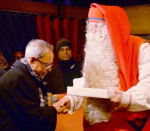 The terrapin, discovered at Allahabad Fort in 1803 during the excavation of a cistern, is carved out of a single piece of jade stone, and the artefact now adorns a corner of the British Museum in London. – Farhan Ahmed Siddiqui
The terrapin, discovered at Allahabad Fort in 1803 during the excavation of a cistern, is carved out of a single piece of jade stone, and the artefact now adorns a corner of the British Museum in London. – Farhan Ahmed Siddiqui
Reshadul Islam, a history buff from Prayagraj, wants the British Museum to return a ‘stolen’ unique artefact back to India. He has shot off an email to Prime Minister Narendra Modi asking him to request his British counterpart to return a jade terrapin (turtle) sculpture that dates to 17th century, when most of India was ruled by the Mughals.
The relic, discovered at Allahabad Fort in 1803 during the excavation of a cistern, is carved out of a single piece of jade stone (green nephrite), and it now adorns a corner of the British Museum in London.
A resident of Chowk area, Reshadul, 50, is a hakim and has studied Unani medicine. When he is not treating his patients, he spends his time researching artefacts and reading about archaeology. He claims that he was in possession of rare books, many of which he has donated to libraries. Overall, he has donated 1,600 books on various subjects to libraries, he said.
Reshadul learnt about the jade terrapin very recently. “I was amazed and shocked to learn that such a magnificent piece of art was stolen from Sangam city and shipped to England by a British officer. I, then, decided to learn more about it and take up the initiative of bringing it back to its place of origin,” he added.
Quoting information available on the Museum website, Lieutenant General Alexander Kyd took the terrapin to England where it was in the possession of his family. In 1830, Kyd’s relative Thomas Wilkinson gave the relic to the British Museum. The sculpture is 20 cm high, 48.50 cm long and 32 cm wide. It weighs 41 kg.
In his letter to Prime Minister Modi, Reshadul has stated that the jade terrapin is of cultural, historical and religious importance for the people of Prayagraj as turtles are considered the reincarnation of Lord Vishnu and signify intellect, good luck and prosperity. The artefact was carved out by the artists of Prince Jehangir’s court in the 17th century and is modelled on a local species of turtle found in the waters of Sangam.
“The holy city is going to host the grand Mahakumbh in 2025 and its residents will feel honoured if the marvelously carved turtle comes back to Prayagraj before the event,” his letter read. – Hindustan Times, 18 December 2023
› Farhan Ahmed Siddiqui is a journalist for the Hindustan Times at Prayagraj, UP.
Filed under: india, UK | Tagged: british in india, british museum, stolen national treasures, terrapin, turtles | Comments Off on British Museum must return stolen jade artefact to Prayagraj – Farhan Ahmed Siddiqui



























